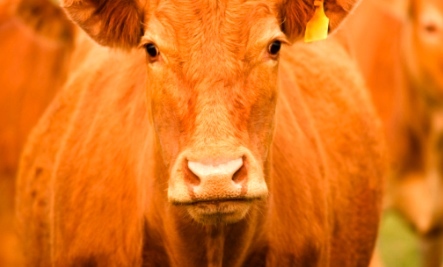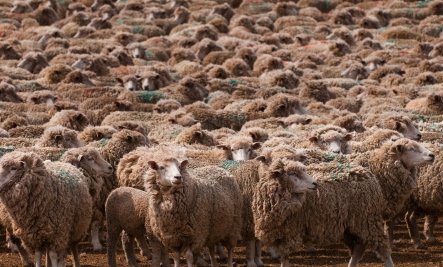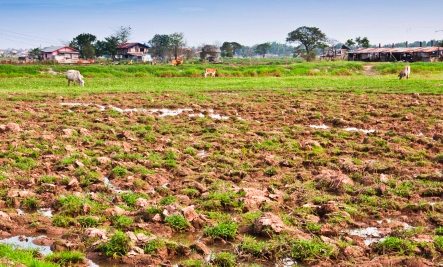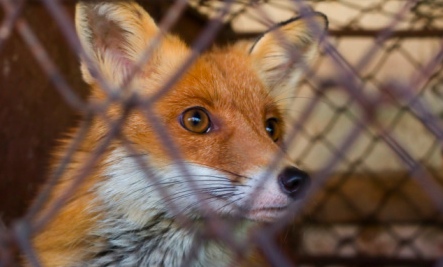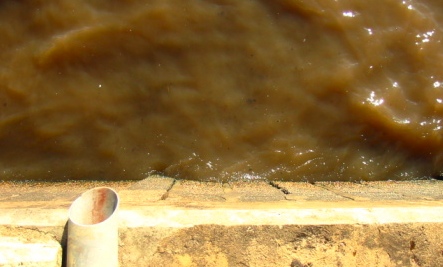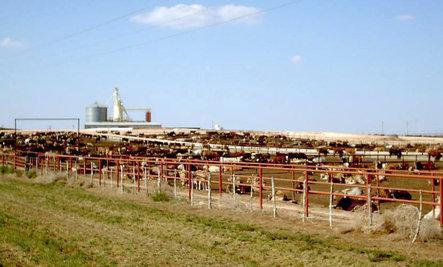In the meat and dairy section of many grocery stores you may noticed packages marked with labels such as “humanely-raised“, “free-range”, “grass-fed”, “organic” or even “cruelty-free.” Each label is designed in its own way to give the consumer a sense that the products that they are purchasing are eco and animal friendly.
You can read more elsewhere about the misleading nature of these labels with regard to animal welfare, but for now let us take a look at what they mean in terms of land use, water, greenhouse gases and protecting native species.
Much of the research cited in this article pertains to cows (often referred to by industry terminology such as “beef” or “cattle”). But with billions of other farmed animals including pigs, chickens, turkeys, goats and sheep living on this planet, it is easy to see that this issue is not just about giving up “red meat.”
The American Meat Institute’s 2010 fact sheet states:
In 2009 the meat and poultry industry killed and processed:
• 8.7 billion chickens
• 246 million turkeys
• 113.6 million hogs
• 33.3 million cattle
• 2.2 million sheep and lambs
And remember, these numbers only pertain to the American meat industry. At the same time that the world population continues to skyrocket, the Western concept of an animal-based diet is also gaining popularity in other countries.
Factory farms were not created because people feel good about cramming animals into overcrowded and unsanitary conditions. They came about due to the growing demand for animal products and economic profit. And the answer to halting the cruelty and environmental destruction inherent in these practices does not lie in organic, local, grass-fed, humanely-raised, cruelty-free or free-range animal products. This research article elaborates on the reasons.
*This article focuses on what the reality of these practices means for the health of our planet. For more information on the ethical issues involved with free-range and organic animal farming, please read these post on “Cage-Free” and “Free-Range” animals.
Land Use:
The United Nations reports:
“Livestock now use 30 per cent of the earth’s entire land surface, mostly permanent pasture but also including 33 per cent of the global arable land used to produce feed for livestock.”
Some people reading this statistic might say: “Well why don’t we stop growing grain for animals and use that land for grazing instead? Doesn’t that solve the issue?”
To start with, many animals such as pigs, turkeys and chickens will continue to be fed grain even if they are free-range. As for the animals that do consume grass, in the U.S. alone there are over 90.8 million* cows being raised for consumption. Each cow requires anywhere from 10,117 to 141,640 square metres of pasture to graze on, depending on the quality of the pasture.
If we use the most conservative figure of close to 10,000 square metres of pasture and multiply it by the number of cows in the US, that means we need approximately 918 billion square metres of fertile land for grazing. This works out to be around 916 million square miles, more than 10% of all the land in the U.S. And this number is ONLY for cows. It does not account for the space needed for over 2.2 million sheep and lambs to graze, or for giving 113.6 million pigs, 246 million turkeys, 8.7 BILLION chickens** adequate space to live in. Nor does it account for the space needed for continuing to grow grain for farmed animals who cannot survive on grass.
It is also important to note that unless grass-fed cows are being raised in a tropical area (more on the Brazilian rainforest coming up soon) they still need to be fed grain during the lean or winter months.
Some people argue that cows and other grass-fed animals such as sheep can be raised on “marginal lands” that cannot be used for growing crops or sustaining a forest.
This is the definition of marginal land:
“Arid and generally inhospitable land. Marginal land usually has little or no potential for profit, and often has poor soil or other undesirable characteristics. This land is often located at the edge of deserts or other desolate areas.”
If marginal lands were used for grazing, the quality and quantity of grazing material would not be enough to support one cow for each 10,117 square metres. Thus the higher estimate of 141,639 square metres per cow would be more accurate. With 90.8 million cows needing 141,639 square metres a cow, we would need 14 billion square metres of marginal land for grazing. This works out to be over 12 million square kilometres of marginal grazing land. The whole of the United States is only 98 million square kilometres, so the math just does not work out.
Even if we could find the open grazing space to place these animals, what about the native species that are already present? Would they simply peacefully co-exist?
*These numbers are taken from the USDA’s semi-annual report for 2012.
**These numbers are for the animals killed in 2009 other than cows. When you take into account the animals being kept alive for their milk, eggs, and other body products such as wool, the actual number of farmed animals is significantly higher.
Destruction of native species:
Managing animals spread over a vast amount of space naturally requires more resources. Amongst other things, this includes rounding up, transporting and “protecting livestock from predators”. What “protecting livestock from predators” really means though, is prioritizing the life of one animal over another. The fences ranchers put up also interfere with wildlife being able to move across the country freely in order to find food and water.
Right now only three percent of the beef produced in the U.S. is grass-fed, and already, thousands of animals are killed or displaced to protect livestock. The USDA’s Animal Damage Control (ADC) programme was established in 1931 with the purpose of suppressing, exterminating and “managing” wildlife that are deemed detrimental to livestock. In 1997, for marketing and image purposes, the federal government changed the name of the ADC to “Wildlife Services.” At the same time, they coined the motto “Living with Wildlife.”
According to a USDA website:
Wildlife Services “provides Federal leadership and expertise to resolve wildlife conflicts and create a balance that allows people and wildlife to coexist peacefully.”
To many inquisitive individuals, the term “peacefully co-existing” may include killing other sentient beings. Yet Wildlife Services regularly commits to initiatives that kills off native species through poisoning, trapping, snaring, “denning*”, shooting, and aerial gunning.
The list of animals that Wildlife Services are sanctioned to displace or kill include, but are not limited to, wild horses, badgers, black bears, bobcats, coyotes, gray fox, red fox, mountain lions, opossum, raccoons, striped skunks, beavers, nutrias, porcupines, prairie dogs, black birds, cattle egrets, and starlings. This list is long, but it is not exhaustive. And while Wildlife Services are finding new ways to “peacefully co-exist” with native species, domestic dogs, cats and threatened/endangered species are often unintentionally killed as well. Even with these deaths unaccounted for, Wildlife Services are still said to intentionally kill more than 1.5 million wild animals annually. All of this is in large part paid for with tax dollars from Americans.
*‘Denning’ is defined as pouring kerosene into an animal’s den and then setting fire to it, burning the young animals alive in their nests.
Why the Rainforest is being torn down:
As mentioned, if cows are not raised in a tropical area, during the winter months they must be fed grain and, to some extent, sheltered or moved to a warmer climate. To sidestep this issue, among other economic reasons, much of the “free-range” beef in the US is raised in other countries (Brazil) or on the formally pristine hills of Hawaii.
Last year, a scientist in the journal of Environmental Science & Technology stated that cows raised for consumption in Brazil are the primary drivers of rainforest deforestation, which is in turn one of the world’s largest contributors to climate change!
While the demand for grass-fed and free-range beef is a large part of what is driving farmers to cut down the rainforest, there is more to this destruction than meets the eye.
Pastures destroyed:
Many people assume that as animals such as cows, sheep and goats wander around grazing, their poop naturally fertilizes the grass and improves soil fertility.
After a period of time, manure will break down and turn into soil, but before it does so the nitrogen (and other nutrient) content is so high it will actually “burn” the plants and grass on which it falls. As the animals move about, the ground also becomes compacted, while native plant species are trampled and noxious weeds spread. This causes the land to become “cow-burned” and unusable for grazing for an extended period of time, or even indefinitely, depending on the level of damage done.
And what happens to our atmosphere and water supply as all that excrement breaks down?
Clean Water and Greenhouse Gases:
The United Nations Environment Programme (UNEP) report*, showed that on the global scale (largely due to the meat and dairy industry), 70% of freshwater consumption, 38% of total land use and 14% of the world’s greenhouse gases are attributed to agricultural production. Professor Edgar Hertwich, the lead author of this report, stated that: “Animal products cause more damage than [producing] construction minerals such as sand or cement, plastics or metals. Biomass and crops for animals are as damaging as [burning] fossil fuels.”
This may not be news, but it is still rather alarming and frustrating to see how much freshwater is being used by the meat and dairy industry each year, especially at the same time that millions of people are becoming ill from waterborne parasites, viruses and bacteria caused by human and animal waste in their water. To add insult to injury, the majority of that same animal waste found its way into our water systems through the very same meat and dairy industry which is gobbling up the majority of our fresh water.**
While the majority of pollution caused by agricultural runoff is attributed to factory farms, this issue is not simply going to disappear by spreading over 90.8 million free-range cows across the country and subsequently closer to the fresh water streams, rivers and ground water reserves which run through and under the very pasture they would graze upon.
But what about the greenhouse gases produced by farmed animals? That must get better when they are not in over crowed factory farms…
*Assessing the Environmental Impacts of Consumption and Production Priority Products and Material
**To learn more about this issue, read Faecal Matters by Angel Flinn.
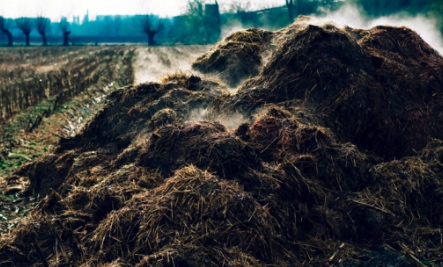
Greenhouse gases from free-range and grass-fed animals:
The final myth about these “alternatives to factory farming” that I would like to explore is that of green house gases. Each year new reports come out about how much methane and nitrous-oxide farmed animals produce and its mounting impact on the environment. Well if the pork is organic, the chicken free-range and the cows grass-fed then may just do something to reduce greenhouse gases…
If fact Nathan Pelletier of Dalhousie University in Halifax, Nova Scotia estimated that pasture-raised cows produce 50% MORE green house gases than feedlot (factory farmed cows). Many may ask why so.
It is rather logical. Cows subsisting on grass grow much slower (at their natural pace) than cows fed on grain. Thus, it takes much longer for them to be ready for slaughter. The longer it takes the cows to grow, the more grass they must eat, and the more methane and nitrous-oxide they emit. It is also worth noting that most of those vast pastures they are grazing on are also enhanced with fertilizers, which the cows ingest as they graze.
As mentioned, spreading an issue out does not mean it goes away. Animals must still eat, defecate, drink, and move about, and with these simple acts comes many of the same issues created by industrial animal farming.
So thus we come to the final frontier:
What about buying local?
Every aspect of animal farming that has been addressed applies to local farms as well. No matter how you package it and no matter how you label it, an animal-based diet is not sustainable.
With the population expected to reach 9.1 billion people by 2050, our cultural, political and culinary defenses have to be addressed and start taking real stock of the impact our dietary choices make. In life there are often many things we cannot control, but thankfully, our diet is one of the things we do have a choice about.
We have come to a point where even the UN is telling us to switch to a vegan diet:
“Impacts from agriculture are expected to increase substantially due to population growth increasing consumption of animal products. Unlike fossil fuels, it is difficult to look for alternatives: people have to eat. A substantial reduction of impacts would only be possible with a substantial worldwide diet change, away from animal products.”
It is our everyday choices that are creating the environmental crisis the world is facing today, and it is our everyday choices that may still be able to save us.
Becoming vegan is not just about environmental or health benefits though because becoming vegan requires us to acknowledge each sentient being’s right to life. The environmental destruction that the meat and dairy industry has been allowed to inflict on our planet is only a symptom of how we have blinded ourselves to not just what we are eating, but whom. It is time to open our eyes, minds, and most important, our hearts, and choose life for the animals, the planet and ourselves.
Adapted from an article by Alisa Rutherford-Fortunati

